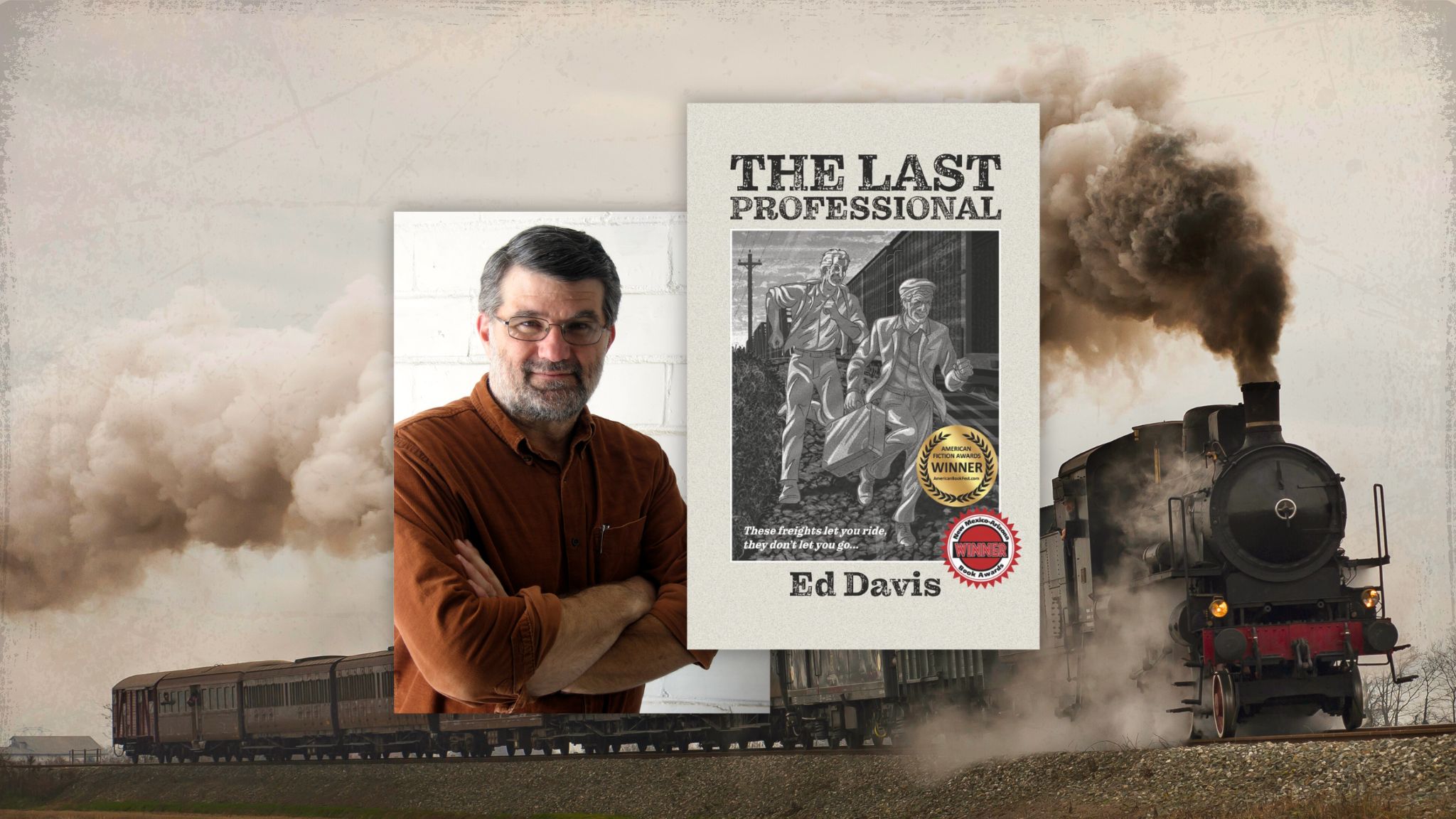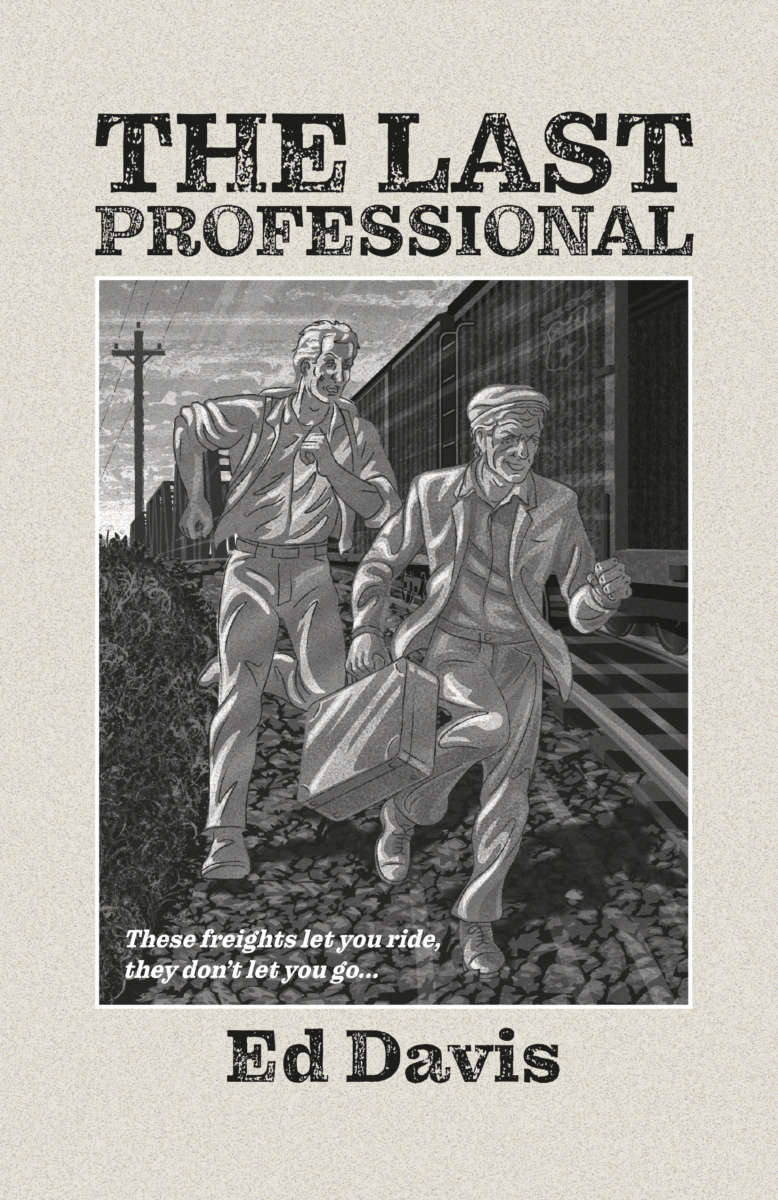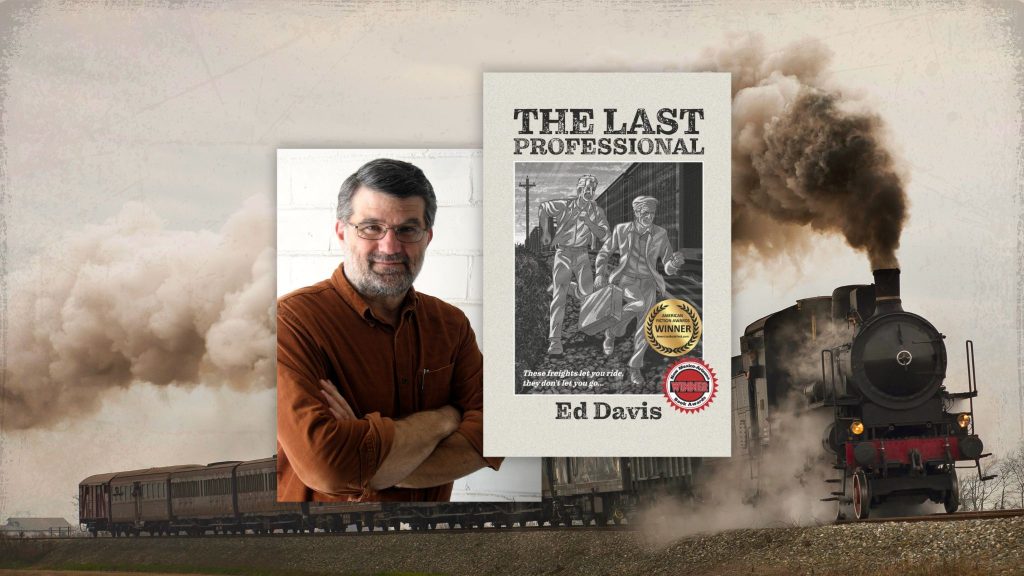
The Last Professional by Ed Davis
When describing The Last Professional (Artemesia Publishing, LLC) by Ed Davis, Jerry Cimino, Founder of the Beat Museum in San Francisco, had this to say: “Davis has done for American railroads what Kerouac did for American highways and Steinbeck did for American nomads.”
High praise — and well-deserved, given that the novel was named the 2022 American Fiction Award thriller winner. It’s amazing that all this can happen writing about a fraternity of tramps, what Davis calls a “brotherhood of travelers who emerged with the coming of the great iron roads and who held dominion over them for more than a century.” Yet maybe it is precisely the scrutiny given this band of hobos and the slice of America they observe and embrace that makes The Last Professional so powerful.
We talked with the author about what inspired this sprawling story of the American landscape and its inhabitants who live on the edge of society.
Q: A hobo, a wanderer, a madman — three characters hurtling toward a heart-wrenching climax where their way of life, and their lives, hang in the balance. Put this in context for us and tell us the basic storyline of The Last Professional.
A: The protagonist, Lynden Hoover, was abducted by a tramp as an eleven-year-old boy. Fifteen years later he returns to the rails to confront this trauma from his past. He meets an old hobo, The Duke, the last of the true Knights of the Road. The Duke’s sworn enemy, Short Arm, is bent on his destruction. It is the early 1980’s. The Duke is clinging to his vanishing lifestyle, and his life. He helps Lynden, who he names Frisco, in the young man’s quest. Frisco helps the old man survive. Their story plays out on The River of Steel, a world of the rails, jungles, hobos, tramps and bums — a hidden America of beauty and brutality, loneliness and loyalty, that was all around us.
Q: Where did you get the idea for The Last Professional?
A: For me, the best fiction deals with the big questions that we all ask ourselves. Who are we? How do we fit in? Where do we belong? The backdrop of a sub-culture without laws, an America without limits, seemed like a perfect place for those answers to play out. Steinbeck explored this territory in The Grapes of Wrath and Of Mice and Men. Kerouac did the same with much of his work. Our history is filled with literary wanderers, and while progress may have tamed our wilderness, it has not dampened our wanderlust.
Q: What kind of research did you have to do to nail this seldom-explored slice of American life?
A: From the early 1970’s to the early 1980’s, I rode tens of thousands of miles as a part-time hobo. While the travel was never easy, often dangerous and always illegal, I found it mesmerizing. There were not many people riding in those days, though I occasionally had the opportunity to share a boxcar with one of the last of the old hobos. Men like The Duke in my story.
Q: What was the most fascinating thing you learned about these hobos?
A: Those who rode the rails fell into three broad categories. Hobos worked and wondered. Tramps just wandered. Bums did neither. Most hobos used the freights as a means of getting from one job to the next. Journeymen of manual labor, they often did work that others wouldn’t. But a small subset of them, men known as Profesh — Professional hobos — worked to wonder. They were never more at peace than when they were on the move.
Q: In a strange way, you show the beauty of their existence while on the surface their journeys seem very difficult. Tell us about that.
A: Anyone who is gripped by a passion — whether it be mountain climbers who summit the 14 tallest peaks — surfers who mount their boards 365 days a year regardless of the weather or the waves — long distance runners who notch marathons in all 50 states — will tell you about the rewards, not the challenges. Such compulsions may not be healthy, but there is no denying their power. How many of us devote our lives, entirely, to the thing that we love? How many would do so if given the chance?
Q: What do you hope readers take away from this story?
A: A little adventure is good for the soul. I hope this book takes readers to a place that, though it is as close as the nearest railroad track, they can’t go on their own. And I hope that, within these characters, they can see some of the best parts of themselves.
Q: What’s your next project?
A: John Updike, in his series of Rabbit novels, did a great job of chronicling his post-war generation through the lives of small-town characters that we recognize and come to know intimately over time. I hope to do the same thing for my generation in a trilogy that follow the lives of four friends who meet in high school in 1968. It takes place in the fictional farming town of O’Farrell in Northern California. We share their lives from their teens into their seventies. I finished the first volume, Four in Stone, two years ago, and I’m just now competing the second volume, Four in Love. The third volume, tentatively titled Four in Time, will hopefully be done by the end of 2024.
Ed Davis is the author of the novella In All Things, a fictionalized account of his training year as a psychiatric technician at the country’s largest institution for the developmentally disabled. His travel collection, Road Stories, details adventures from skid rows to the Sierras, an African hospital to ancient Inca ruins high in the Andes. His death row thriller, A Matter of Time, was written in real time, in 24 hours, as the last day of the hero’s life unfolds. His work has appeared in Gris-Gris, New English Review, Potato Soup Journal, The Penmen Review, Rougarou and The Umbrella Factory Magazine. A runner, backpacker and master’s level discus thrower, Ed and his wife Jan live in Northern California, not far from Jack London’s Beauty Ranch. Visit www.eddavisbooks.com and Ed Davis’ official YouTube page.

Publish Date: January 25, 2022
Genre: Fiction
Author: Ed Davis
Page Count: 278 pages
Publisher: Artemesia Publishing, LLC
ISBN: 9781951122256

